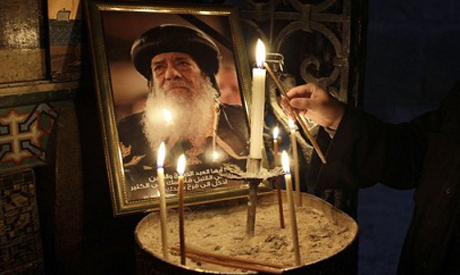Pope Shenouda exhibition opens in Cairo
Nevine El-Aref
16/8/2012
Abbaseya Cathedral hosts exhibition charting life of Coptic Christian Pope Shenouda III, who died in March 2012.
Christians have long flocked to Cairo’s awe-inspiring Abbaseya Cathedral to pray and attend religious services. They will now be joined by Muslims wanting to see the personal belongings of Pope Shenouda III, the 117th Coptic pope and patriarch of Alexandria, who died in March.
Over 60 items charting Pope Shenouda’s career as a monk from 1954 until his death are on display at the Coptic Cultural Centre inside the cathedral.
The exhibition, which is called ‘So as not to forget’, was inaugurated with little fanfare in early August. In attendance were Antiquities Minister Mohamed Ibrahim, Pope Shenouda’s secretary and head of the Coptic Cultural Centre Bishop Amria, the Church’s acting patriarch Bishop Pachomius, as well as top Coptic Church officials and prominent public figures.
Most of Shenouda’s personal belongings are displayed inside special glass showcases, fabricated in the workshops of the antiquities ministry, including books, crosses, bibles and his official monastic suits. His mobile phone, watch, beads, clay pot and teapot are also exhibited along with a collection of personal photos showing Pope Shenouda with public figures, such as former US president Jimmy Carter, current US President Barack Obama and other Arab presidents and leaders.
Awards such as the UNESCO Madanjeet Singh Prize for the promotion of Tolerance and Non-Violence are also on display.
Letters written by Pope Shenouda commemorating the death of the late Grand Imam of Al-Azhar Mohamed Sayed Tantawi are also on show, as well as another one written by Field Marshall Tantawi to Shenouda greeting him at a Christian festival.
In a corner of the exhibition is a replica of the pope’s cell with his original bed, lamp, chair and desk.
The exhibition will eventually be transferred to Saint Bishoy monastery in Wadi El-Natroun on the north coast, where Pope Shenouda is buried.
“It is really a great exhibition relating the life of a prominent clergyman who spent his life calling for mercy and tolerance,” Louay Mamoud Saeed, head of the Coptic Studies Programme at the Bibliotheca Alexandrina, told Ahram Online. He described it as an opportunity for Christians to renew their acquaintance with his religious philosophy and for Muslims to learn something about his life.
Saeed went on saying that the exhibition was meant to be at the Coptic Museum in Old Cairo, but due to security reasons the exhibition was transferred to the Coptic Cultural Centre at Abbaseya Cathedral.
The Coptic Museum’s security chief said he would not be able to secure the items because of the predicted influx of visitors, said Saeed. He also mentioned the chaos that had happened at the Saint Bishoy monastery during the ceremony held there 40 days after the pope’s death, which led to the death and injury of several people.
“I am very happy to see such an exhibition. It is a dream come true,” said Hala Metry, who was admiring one of the pope’s crosses. She told Ahram Online that such an exhibition will reminds us of a pope that we loved, and it will keep us spiritually in connection with him after his death. “He will always be in our hearts and souls.”
Peter Mo’anes says the exhibition should be bigger and in a museum of its own along with other objects from previous popes, like the one at Saint Catherine Monastery in South Sinai.
Pope Shenouda III was widely acclaimed by Christians and Muslims in recent years for his efforts to contain sectarian tensions following a number of incidents, such as the burning of churches, but he was also criticised for turning the Church into a political entity.
He started his monastic career at the Syrian monastery of the Ever-Virgin Mary in 1954 and in November 1971 he was consecrated Egypt’s pope and presided over a worldwide expansion of the Coptic Orthodox Church.

